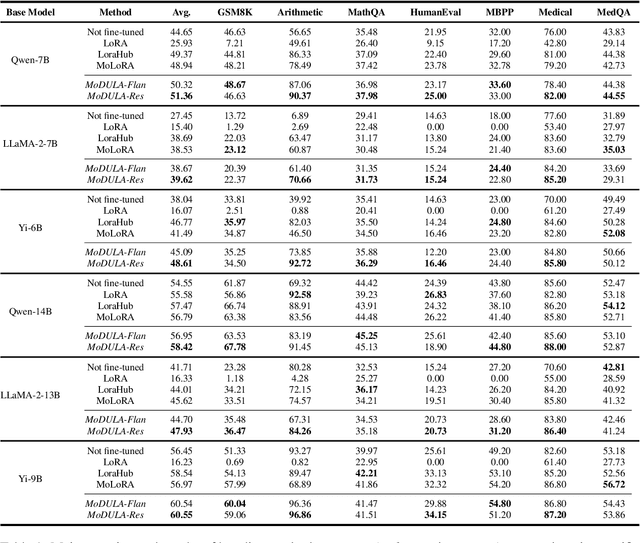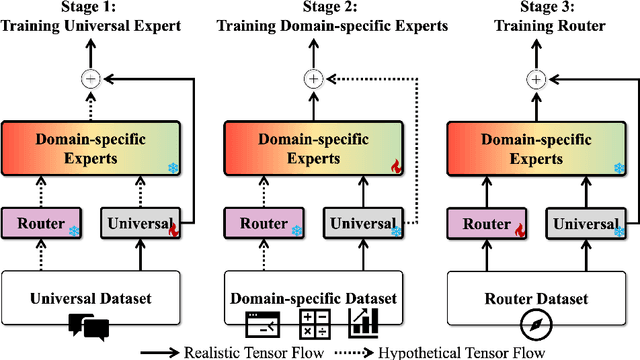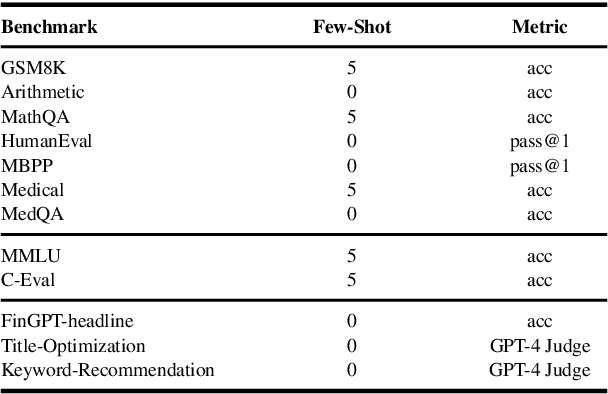Huangyu Dai
MoDULA: Mixture of Domain-Specific and Universal LoRA for Multi-Task Learning
Dec 10, 2024



Abstract:The growing demand for larger-scale models in the development of \textbf{L}arge \textbf{L}anguage \textbf{M}odels (LLMs) poses challenges for efficient training within limited computational resources. Traditional fine-tuning methods often exhibit instability in multi-task learning and rely heavily on extensive training resources. Here, we propose MoDULA (\textbf{M}ixture \textbf{o}f \textbf{D}omain-Specific and \textbf{U}niversal \textbf{L}oR\textbf{A}), a novel \textbf{P}arameter \textbf{E}fficient \textbf{F}ine-\textbf{T}uning (PEFT) \textbf{M}ixture-\textbf{o}f-\textbf{E}xpert (MoE) paradigm for improved fine-tuning and parameter efficiency in multi-task learning. The paradigm effectively improves the multi-task capability of the model by training universal experts, domain-specific experts, and routers separately. MoDULA-Res is a new method within the MoDULA paradigm, which maintains the model's general capability by connecting universal and task-specific experts through residual connections. The experimental results demonstrate that the overall performance of the MoDULA-Flan and MoDULA-Res methods surpasses that of existing fine-tuning methods on various LLMs. Notably, MoDULA-Res achieves more significant performance improvements in multiple tasks while reducing training costs by over 80\% without losing general capability. Moreover, MoDULA displays flexible pluggability, allowing for the efficient addition of new tasks without retraining existing experts from scratch. This progressive training paradigm circumvents data balancing issues, enhancing training efficiency and model stability. Overall, MoDULA provides a scalable, cost-effective solution for fine-tuning LLMs with enhanced parameter efficiency and generalization capability.
Contrastive Token Learning with Similarity Decay for Repetition Suppression in Machine Translation
Sep 30, 2024



Abstract:For crosslingual conversation and trade, Neural Machine Translation (NMT) is pivotal yet faces persistent challenges with monotony and repetition in generated content. Traditional solutions that rely on penalizing text redundancy or token reoccurrence have shown limited efficacy, particularly for lengthy article and e-commerce descriptions with inherent redundancy, even with the advent of Large Language Models (LLMs). This paper investigates the underlying causes of textual repetition through the lens of information entropy, attributing the phenomenon to the elevated uncertainty within the input text. To address this, a novel algorithm named Contrastive Token Learning with Similarity Decay (CTSD) is introduced, which modulates the suppression of tokens dynamically, informed by varying attention weights and inter-token distances. Furthermore, an e-commerce dataset comprised of title texts of online real items is compiled and released susceptible to hallucination translations to benchmark the algorithm. Extensive evaluations demonstrate that CTSD significantly outperforms existing approaches in precision and generalizability. Additional online A/B testing underscores its practical value, showing marked improvements in user engagement and conversion. Notably, this method has been implemented with full traffic on eight multilingual sites of alibaba.com, the largest B2B e-commerce platform in the world.
Robust Interaction-based Relevance Modeling for Online E-Commerce and LLM-based Retrieval
Jun 04, 2024Abstract:Semantic relevance calculation is crucial for e-commerce search engines, as it ensures that the items selected closely align with customer intent. Inadequate attention to this aspect can detrimentally affect user experience and engagement. Traditional text-matching techniques are prevalent but often fail to capture the nuances of search intent accurately, so neural networks now have become a preferred solution to processing such complex text matching. Existing methods predominantly employ representation-based architectures, which strike a balance between high traffic capacity and low latency. However, they exhibit significant shortcomings in generalization and robustness when compared to interaction-based architectures. In this work, we introduce a robust interaction-based modeling paradigm to address these shortcomings. It encompasses 1) a dynamic length representation scheme for expedited inference, 2) a professional terms recognition method to identify subjects and core attributes from complex sentence structures, and 3) a contrastive adversarial training protocol to bolster the model's robustness and matching capabilities. Extensive offline evaluations demonstrate the superior robustness and effectiveness of our approach, and online A/B testing confirms its ability to improve relevance in the same exposure position, resulting in more clicks and conversions. To the best of our knowledge, this method is the first interaction-based approach for large e-commerce search relevance calculation. Notably, we have deployed it for the entire search traffic on alibaba.com, the largest B2B e-commerce platform in the world.
General2Specialized LLMs Translation for E-commerce
Mar 06, 2024Abstract:Existing Neural Machine Translation (NMT) models mainly handle translation in the general domain, while overlooking domains with special writing formulas, such as e-commerce and legal documents. Taking e-commerce as an example, the texts usually include amounts of domain-related words and have more grammar problems, which leads to inferior performances of current NMT methods. To address these problems, we collect two domain-related resources, including a set of term pairs (aligned Chinese-English bilingual terms) and a parallel corpus annotated for the e-commerce domain. Furthermore, we propose a two-step fine-tuning paradigm (named G2ST) with self-contrastive semantic enhancement to transfer one general NMT model to the specialized NMT model for e-commerce. The paradigm can be used for the NMT models based on Large language models (LLMs). Extensive evaluations on real e-commerce titles demonstrate the superior translation quality and robustness of our G2ST approach, as compared with state-of-the-art NMT models such as LLaMA, Qwen, GPT-3.5, and even GPT-4.
 Add to Chrome
Add to Chrome Add to Firefox
Add to Firefox Add to Edge
Add to Edge